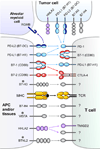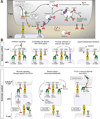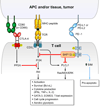Coinhibitory Pathways in the B7-CD28 Ligand-Receptor Family
- PMID: 27192563
- PMCID: PMC4905708
- DOI: 10.1016/j.immuni.2016.05.002
Coinhibitory Pathways in the B7-CD28 Ligand-Receptor Family
Abstract
Immune responses need to be controlled for optimal protective immunity and tolerance. Coinhibitory pathways in the B7-CD28 family provide critical inhibitory signals that regulate immune homeostasis and defense and protect tissue integrity. These coinhibitory signals limit the strength and duration of immune responses, thereby curbing immune-mediated tissue damage, regulating resolution of inflammation, and maintaining tolerance to prevent autoimmunity. Tumors and microbes that cause chronic infections can exploit these coinhibitory pathways to establish an immunosuppressive microenvironment, hindering their eradication. Advances in understanding T cell coinhibitory pathways have stimulated a new era of immunotherapy with effective drugs to treat cancer, autoimmune and infectious diseases, and transplant rejection. In this review we discuss the current knowledge of the mechanisms underlying the coinhibitory functions of pathways in the B7-CD28 family, the diverse functional consequences of these inhibitory signals on immune responses, and the overlapping and unique functions of these key immunoregulatory pathways.
Copyright © 2016 Elsevier Inc. All rights reserved.
Figures



References
-
- Agata Y, Kawasaki A, Nishimura H, Ishida Y, Tsubata T, Yagita H, Honjo T. Expression of the PD-1 antigen on the surface of stimulated mouse T and B lymphocytes. International immunology. 1996;8:765–772. - PubMed
-
- Alegre ML, Noel PJ, Eisfelder BJ, Chuang E, Clark MR, Reiner SL, Thompson CB. Regulation of surface and intracellular expression of CTLA4 on mouse T cells. J Immunol. 1996;157:4762–4770. - PubMed
-
- Anjos S, Nguyen A, Ounissi-Benkalha H, Tessier MC, Polychronakos C. A common autoimmunity predisposing signal peptide variant of the cytotoxic T-lymphocyte antigen 4 results in inefficient glycosylation of the susceptibility allele. J Biol Chem. 2002;277:46478–46486. - PubMed
Publication types
MeSH terms
Substances
Grants and funding
LinkOut - more resources
Full Text Sources
Other Literature Sources
Medical

